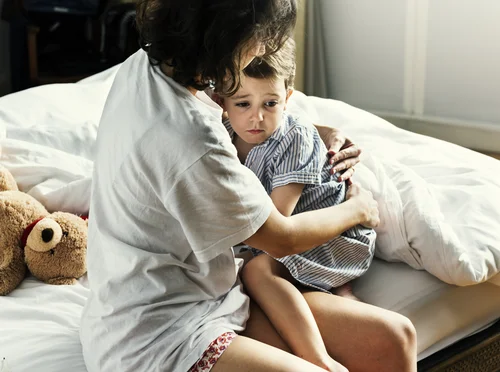Nightmares and night terrors are confusing in both cause and treatment. Knowing the difference between the two is the key to determine the best way to handle them.
What is a nightmare?
Nightmares occur during REM sleep, which happens near the end of our sleep cycle and more often later in the night. When children have a nightmare, they will seek comfort from their parents and recognize you upon seeing you. They are able to recall the nightmare, but it may take awhile to fall back asleep and get the scary thoughts out of their minds. Nightmares are very common and are part of normal development. Their occurrence often peaks around two or three years of age when children have rich imaginations and trouble distinguishing between reality and fantasy. Nightmares are, of course, common after difficult events or when children are re-living a trauma.
Here is how to cut down on nightmares:
- Avoid scary videos, books, etc. prior to bed.
- Do not play scary games.
- Respond quickly when your child has a nightmare and assure him that he is safe.
- Help your child get enough sleep. Sleep deprivation can increase nightmares.
- Help your child ease into bedtime with a healthy peaceful bedtime routine
- Avoid high-dose vitamins at bedtime.
- Check with your pediatrician to make sure your child is not on any medications that might be interfering with his night sleep.
Here is what you can do to help your child go back to sleep after a nightmare.
- Reassure your child that you are there. Be calm and present in his moment of fear. Your calm presence is so reassuring in itself.
- Label what happened. Let you child know it was a nightmare and now its over. Reassure him that the bad dream was only a dream and it didn’t happen in the real world.
- Offer comfort. Empathize with him. Relate to his fear and tell them its ok to feel that way.
- Do a little mommy magic. Your kids really do think you have magical powers so use them. Create a fake magic spray and tell them that you sprayed away the bad dream in the room.
- Lighting. A nightlight or hall light or a bedside flashlight can help
- A bit of your bed routine again. A quick happy song or prayer or kiss and tuck them in and leave them to drift off to sleep again.
Night Terrors
Night terrors are different from nightmares in both the symptoms and the experience. When a child is experiencing a night terror she may scream and appear anxious and may not recognize you when you approach her. There may also be sweating and/or a racing heartbeat. The child is often inconsolable. The terror usually lasts between five and fifteen minutes and then subsides.
These incidents are often more upsetting for the parent than they are for the child, as children do not usually remember them. Night terrors occur during NON-REM sleep and usually occur within two hours of going to sleep. Night terrors are not bad dreams. They do not occur during dream sleep. They are not a sign of a psychological problem.
Night terrors seem to be more common in boys, and occur in 5% of all children. Sometimes they occur when your child is working on a developmental milestone. Your child is more likely to have night terrors if either parent had them as a child, or if either parent had a partial arousal sleep disorder such as sleepwalking. The most common cause of night terrors is sleep deprivation or a disturbance in a child's sleep patterns—like traveling to different time zones, a new home or a later bedtime. Other reasons for night terrors can include sleep apnea and fevers.
Here are some tips on how to handle night terrors:
- If your child is having a night terror, monitor the child but avoid interfering, as this can worsen the episode.
- Make sure your child is physically safe during the night terror.
- Put your child to bed earlier.
- Keep a regular sleep schedule for him.
- Don't talk about the terror with your child in the morning.
- If your child is having night terrors two to three times a week at set times during the night (i.e. 2 hours after going to sleep) try the following:
- Keep a sleep log to track your child's sleep patterns.
- Wake your child 15 minutes prior to the time he usually has an episode.
- Do this every night for 7-10 nights in a row and you will most likely see the episodes start to diminish.
As these two experiences differ so greatly in treatment, it is important to clearly understand the difference between nightmares and night terrors. Once you know what you are dealing with, you will be able to help your child cope and get back to sleep.


